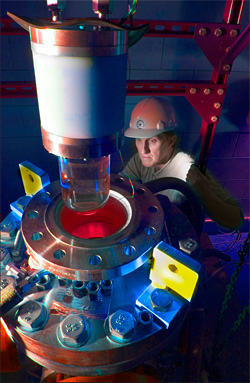
FACT SHEET: Click here to download PDF.
NAME: Chicagoland Observatory for Underground Particle Physics, or COUPP
WHAT WILL THIS TELL US ABOUT THE WORLD? Everything you see, visible matter, makes up 4 percent of the universe. Dark matter and dark energy makes up the rest of the universe. Physicists understand that dark matter acts as an invisible source of gravity, but little more.
COUPP seeks to pinpoint what particles make up dark matter, which will help explain how the universe came to exist. Without the added gravitational attraction of dark matter, stars and galaxies would never have formed. The expansion of the universe after the Big Bang would have dispersed visible matter too quickly.
WHY IS THIS EXPERIMENT NEEDED NOW? Physicists have narrowed the hunt for what particles constitute dark matter to those that are heavy, neutral and interact very weakly with other matter particles. Only this type of particle fits with the way the universe evolved and its matter density.
WHAT IS COUPP LOOKING FOR? A nuclear recoil from a dark matter particle striking a nucleus of an atom in a liquid molecule. That triggers the evaporation of a small amount of liquid, which causes a bubble to start growing. The correct type of bubble would point to the existence of a leading candidate for dark matter called Weakly Interacting Massive Particles, or WIMPs.
FUNDED BY: DOE and NSF
NUMBER OF COLLABORATORS: 20
U.S. COLLABORATING INSTITUTIONS: Two universities, one national laboratory
NON-US COLLABORATING INSTITUTIONS: One national laboratory in Canada
HOW DOES THIS FIT INTO FERMILAB’S STRATEGIC PLAN? Fermilab scientists search for dark matter WIMPs using four different technologies: bubble chambers (COUPP), cryogenic crystals (CDMS), liquid argon (Darkside) and Charge Coupled Devices (DAMIC).
STATUS: COUPP started in 2004. A 4–kilogram bubble chamber was installed at SNOLAB in September 2010. A second 60–kg chamber will follow in late 2010.
LIFESPAN OF EXPERIMENT: The deployment of a 500 kg chamber in a deep underground site is expected in 2013. It will operate for a number of years.
PHYSICS FRONTIER EXPLORING: Cosmic Frontier
HOW DOES IT WORK? A quartz jar serves as a bubble chamber and holds a liquid kept just above its normal boiling point, but under enough pressure that it will not boil unless disturbed. When a charged particle zips through the liquid, it triggers boiling along its path, visible as a series of small bubbles. Scientists expect a dark matter particle to leave a single bubble in a particular area of the jar in contrast to the multi-bubble tracks left by many other particles. Once the bubbles reach a millimeter in size, researchers take snapshots and let the chamber sit recompressed and idle for about 30 seconds. It is then reset and ready to record another series of bubbles.
FUN FACTS:
- COUPP revives and updates a technology not popular since the 1970s: the bubble chamber.
- The detector sits more than one-mile underground at SNOLAB, which sits atop a working nickel mine.
- A prototype bubble chamber was tested 330-feet underground in Chicago’s flood–control and sewers infrastructure, called the Tunnel and Reservoir Project.
- The first one-liter chamber was tested 350 feet below Fermilab in the NuMI tunnel.
- Liquid in the chamber is on the verge of boiling 80 percent of the experiment time.
- The COUPP bell jar contains iodotrifluoromethane, a fire-extinguishing liquid known as CF3I.
- COUPP can use the sound of bubbles to differentiate between potential dark matter signals background noise from common alpha particles such as radon. Bubbles give off a high-pitched "plink", like a submarine’s sonar.
WHAT EXPERIMENTS DOES IT BUILD ON? SIMPLE and PICASSO
WHO IS THE MAIN COMPETITION? Canadian experiment PICASSO at SNOLAB, University of California at Berkeley-led CDMS II in Soudan Mine in Minnesota and the International experiment XENON 100 at Gran Sasso National Laboratory in Italy.
WHAT MAKES THE EXPERIMENT UNIQUE? The ability to switch the type of liquid in the detector with minimal effort and cost gives the bubble chamber an advantage over other dark matter detection devices. The refrigerant employed is maximally sensitive to the two modes of interaction expected from dark matter particles, due to the presence of both fluorine and iodine. By selecting the operating temperature and pressure, the chamber can be operated in a mode where bubble formation is only triggered by nuclear recoils such as those expected from dark matter interactions, and not by the electron recoils induced by known forms of radiation.
LEARN MORE:
- How the detector works: http://www.symmetrymagazine.org/cms/?pid=1000628
- COUPP website: http://www-coupp.fnal.gov/
- Hear how COUPP listens for dark matter:
http://www.symmetrymagazine.org/breaking/2010/04/16/dark-matter-can-you-hear-me-now/